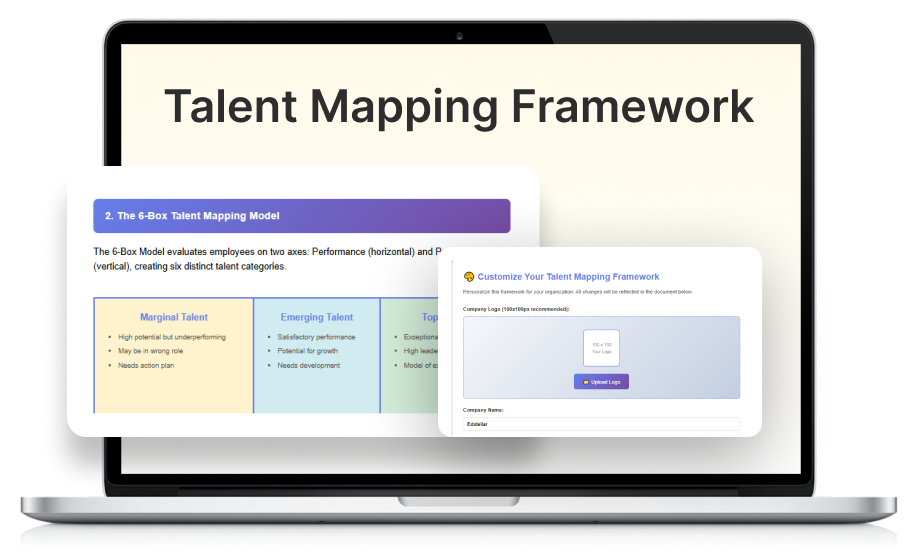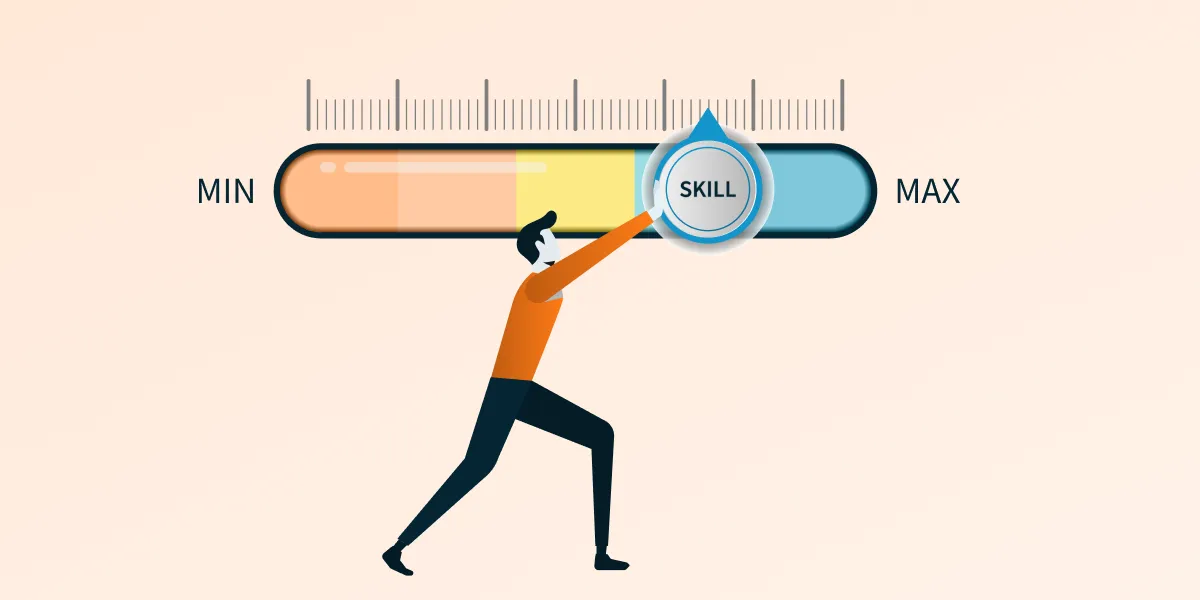The Talent Mapping Framework Template streamlines organizational talent assessment by combining performance and potential review for individuals and teams. Using the 6-Box Model, managers can categorize employees as top talent, emerging talent, role specialists, solid performers, marginal talent, or underperformers. The template provides objective rating scales, modern competencies, and bias-prevention guidelines for fair and effective evaluation. Customized for branding, it includes implementation steps from data preparation to calibration and action planning. The confidential process enables targeted development, succession planning, and holistic workforce optimization while supporting strategic HR and L&D goals. It is suited for annual cycles, mid-year checks, and post-major changes, ensuring talent standards across roles and locations.
What's Inside the Talent Mapping Framework Template?
Discover everything you need to conduct robust and unbiased talent reviews with this template. Inside, find structured sections, practical tools, and clear guidance to help you assess employee performance and potential, categorize talent, avoid common biases, and plan development actions. This framework ensures a holistic, consistent approach to mapping talent across your organization.
Key Components Included
1. The 6-Box Talent Mapping Model
- Visual matrix plotting employees on Performance (horizontal) and Potential (vertical) axes
- Six distinct talent categories: Top Talent, Emerging Talent, Marginal Talent, Role Specialist, Solid Performer, and Underperformer
- Color-coded grid system for quick visual assessment and talent portfolio analysis
- Customizable employee placement grids (generate 1-20 individual assessment grids)
2. Performance Assessment Criteria
- 5-point rating scale with detailed descriptors for each level
- Three core performance dimensions: Commitment to Excellence, Teamwork & Collaboration, and Integrity
- Objective criteria and behavioral indicators for consistent evaluation
- "Show stopper" integrity standards that override all other considerations
3. Potential Assessment Criteria
- Clear distinction between "High Potential" and "At Potential" classifications
- Seven key indicators: Aspiration, Ability, Engagement, Learning Agility, Results Orientation, Strategic Thinking, and Emotional Intelligence
- Readiness timelines for promotion and advancement (12-month benchmark)
- Self-awareness and growth commitment evaluation guidelines
4. Talent Category Definitions
- Comprehensive descriptions for all six talent categories
- Specific action plans and retention strategies for each group
- Investment recommendations (training, development, acceleration programs)
- Timeline guidance for performance improvement or transition decisions
5. Assessment Guidelines & Best Practices
- Who should conduct talent mapping and when (annual cycle, mid-year reviews, role changes)
- Calibration session protocols for cross-team consistency
- Documentation requirements and evidence-based rating support
- Confidentiality and stakeholder communication guidelines
6. Common Biases to Avoid
- Seven common biases with definitions and overcome strategies: Halo/Horn Effect, Recency Bias, Personal Bias, Leniency/Strictness Bias, Similar-to-Me Bias, Attribution Bias, and Confirmation Bias
- Objective evaluation techniques and forced-ranking methodologies
- Diversity, equity, and inclusion considerations throughout the assessment process
7. Modern Competencies Framework
- Five future-ready competency areas: Digital & Technical Agility, Adaptability & Resilience, Innovation & Problem-Solving, Inclusive Leadership, and Remote Work Effectiveness
- Contemporary workplace skills assessment beyond traditional performance metrics
- Competency indicators aligned with hybrid work environments and digital transformation
8. Implementation Guide
- Step-by-step deployment guide for rolling out talent mapping across the organization
- Calibration meeting templates and facilitation guidelines
- Succession planning integration strategies
- Communication plans for transparency and employee engagement
Talent Mapping Framework Template Features
- Fully Customizable: Editable company branding section with logo upload, company name, tagline, date, version, contact information, and website details. Instantly reflects your organization's identity throughout the document.
- Print-Ready Professional Design: Optimized for A4/Letter size printing with clean margins, professional formatting, and export-to-PDF functionality. Perfect for board presentations, talent review meetings, and documentation.
- Interactive Employee Grids: Dynamic grid generator allows creation of 1-20 individual employee assessment matrices. Each grid maintains consistent formatting and can be customized with employee names and placement.
- Best Practice Guidelines: Each section includes practical examples, common pitfalls to avoid, and expert recommendations for maximizing assessment accuracy and development impact.
- Comprehensive Documentation: Built-in table of contents, section headers, and structured format ensure easy navigation and professional presentation for stakeholders.
- Modern Competency Integration: Goes beyond traditional assessment to include digital-age skills, remote work capabilities, and inclusive leadership competencies relevant to today's workplace.
Who Should Use the Talent Mapping Framework Template?
This template is designed for professionals driving talent strategy and organizational effectiveness:
How to Use the Talent Mapping Framework Template?
Input your company branding information in the customization panel at the top of the template. Upload your logo (100*100px recommended), enter company name, tagline, framework date, version number, contact information, and website. Click "Apply Changes & Preview" to see your branding reflected throughout the document.
Familiarize with the performance and potential assessment criteria. Review the 5-point performance rating scale and the High Potential vs. At Potential definitions. Ensure all managers understand the evaluation standards before beginning assessments.
For each employee, evaluate performance across the three core dimensions (Commitment to Excellence, Teamwork & Collaboration, Integrity). Determine potential level based on the seven key indicators. Use the employee grid generator to create individual assessment matrices as needed.
Place each employee in the appropriate talent category based on their performance rating (horizontal axis) and potential classification (vertical axis). This creates a visual talent portfolio for your team or organization.
Conduct calibration sessions with peer managers and HR to ensure consistency in ratings. Discuss borderline cases, challenge rating distributions, and validate assessments with specific examples and evidence.
For each talent category, implement the recommended actions outlined in the framework. Create development plans for emerging talent and top talent, performance improvement plans for underperformers and marginal talent, and retention strategies for role specialists.
Save or print the completed framework as a PDF for documentation and compliance purposes. Communicate assessment results to employees in development-focused conversations, focusing on growth opportunities and next steps.
Conduct mid-year reviews to track progress on development plans and performance improvements. Update talent maps after significant role changes, organizational restructuring, or major project completions. Repeat the full cycle annually.
Benefits of Using a Talent Mapping Framework Template
For Organizations:
Strategic Workforce Planning
Transform talent management from reactive to proactive by visualizing your complete talent portfolio.
Identify skill gaps, succession risks, and development priorities at a glance, enabling strategic resource
allocation and workforce planning aligned with business goals.
Improved Retention of High Performers
Systematically identify and invest in your top talent before competitors do. The framework ensures
high-potential employees receive recognition, development opportunities, and clear career pathways,
significantly reducing regrettable turnover and protecting your talent investment.
Consistent, Fair Assessments
Eliminate subjective evaluations and manager bias through standardized criteria, calibration protocols,
and evidence-based rating systems. Create a culture of fairness and transparency where all employees are
assessed against the same objective standards.
Data-Driven Succession Planning
Build a sustainable leadership pipeline by identifying future leaders early and developing them
systematically. The 6-Box Model provides clear visibility into bench strength for critical roles,
reducing succession risk and enabling smooth leadership transitions.
For HR/L&D/Leadership Professionals
Ready-to-Implement Framework
Access a professionally designed, best-practice template that eliminates months of development work. Customize the framework to your organization's needs and launch talent mapping immediately with confidence, no need to build from scratch.
Enhanced Credibility & Influence
Position HR and L&D as strategic business partners by presenting talent insights using a structured, data-driven framework. Use objective assessment results to influence leadership decisions, secure development budgets, and demonstrate measurable impact on organizational performance.
Efficient Talent Review Process
Streamline annual talent reviews with clear assessment criteria, visual mapping tools, and standardized documentation. Reduce meeting time, minimize preparation burden, and focus discussions on strategic talent decisions rather than debate about rating definitions.
Actionable Development Insights
Move beyond labeling employees to creating meaningful development pathways. The framework connects assessment results directly to specific actions, investment levels, and timelines, ensuring every talent conversation leads to concrete next steps and measurable outcomes.
.svg)





.svg)
.svg)
.svg)


